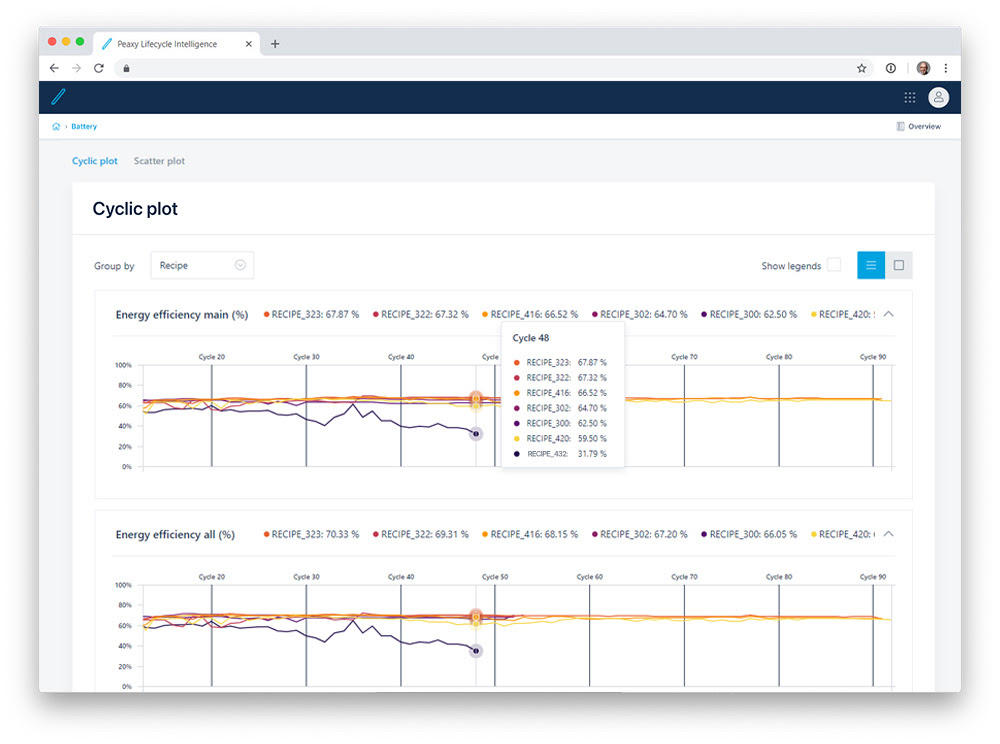How do data analytics play a role in streamlining the manufacturing process?
Data lies at the center of the digital manufacturing process, or what is often called ‘Industry 4.0’. Your ability to automate data capture, normalize it and make it readily accessible and actionable can, in most cases, set your advantage apart from the competition. In many organizations, we see that streams of data are commonly being captured at any point in the process. But much of this data is hidden behind legacy systems and organizational silos, or stuck in manual processes, literally on paper.
Without having a good handle on your data, even the best manufacturing process can be hindered. Since data can come from any number of sources in the manufacturing of batteries, it’s important to be able to thread that data down to the individual serial number over the entire lifecycle of the asset. We accomplish this with customers using a concept known as the ‘Digital Manufacturing Traveler’.
Can you explain what you mean by this concept?
To put it simply, the Digital Manufacturing Traveler captures data from each and every step in the manufacturing process, either from manual user input or an automated equipment feed as part of a quality control process. One of our industrial battery customers uses the Digital Manufacturing Traveler to capture more than 1,800 build and quality control parameters, automating about 95% of data collection on their manufacturing floor. Since data is captured at every step of the manufacturing process, a complete history is formed. This enables new types of analysis that were previously impossible. For example:
-
Associating the built asset with a particular manufacturing equipment used in the assembly line, which can prove useful if there are quality issues later on.
-
Monitoring and analyzing real-time quality test results that help the production manager to identify any calibration or maintenance needed in the equipment.
-
Understanding the state of manufacturing equipment to perform predictive maintenance and process automation, ultimately improving the efficiency of the manufacturing floor.
-
Identifying all products manufactured from a specific lot. This becomes useful if, for example, a deployed battery in the field has an issue with a particular component from a certain supplier. You can easily identify all of the batteries that were built as part of the same lot to ensure that action can be taken to address the issue quickly.
A large part of manufacturing efficiency lies in the ability to control quality. How does the Digital Manufacturing Traveler help with that?
Using the breadth of insight from queryable data, the Digital Manufacturing Traveler enables quality checks to be enforced and ensures that no products can progress in the manufacturing line unless the quality control values are within the design specification limits. In our experience, this is the single most important factor in improving the overall quality of the product and increasing customer satisfaction. We’ve seen that the Digital Manufacturing Traveler with enforced validations can result in up to a 95% reduction in data entry errors by the operator.

Parametrized values help to create automated reports on a daily basis for production managers to do the analysis and perform optimizations to gain manufacturing efficiency.
What about the R&D process? How can something like the Digital Manufacturing Traveler help here?
Using the Digital Manufacturing Traveler during the R&D process is crucial, especially when innovating new battery technologies that involve different battery chemistries. R&D managers need to be able to capture the various process steps and materials. Trying to do this manually using a paper approach or a spreadsheet is error prone and makes it very difficult to do any analysis about the individual process steps, or the overall effectiveness of certain recipes.
The Digital Manufacturing Traveler extends through the entire lifecycle of the test battery. By capturing and analyzing all the test data, as well as the autopsies that follow it, every possible performance factor is parametrized and available to the experiment designers as a queryable feature.

Digitization and data capture during the research and development stage of new battery technologies is critical to identifying the ideal recipe and manufacturing process.
There are frequent claims made about advancements in battery chemistry, be it an increase in energy density or cost reductions due to changes made to the electrolyte. Recently, solid-state batteries are generating quite a buzz. This technology, which does away with the liquid electrolyte, offers significantly improved energy density and safety, as well as an improved environmental impact. Using something like the Digital Manufacturing Traveler for R&D is fully adaptable to all battery types and chemistries whether the battery is using a liquid electrolyte or are solid state, and can be configured to capture and parametrize all attributes used in the R&D process(es) used to create the battery.
When talking about manufacturing efficiencies, what other trends or innovations have you seen?
In addition to working with different battery chemistries, we’re now also seeing a number of battery developers looking to disrupt the industry with new manufacturing methods that can either extract greater performance or create batteries in different form factors. With advancements in 3D printing technologies, it’s now possible to print a battery to an exact specification, both in terms of size and composition. The Digital Manufacturing Traveler is ideally suited to capture both the inputs and outputs required to 3D print a battery. The inputs could include, for example, the materials used in the printing process, the configuration files used in the printer, and the number of layers to be printed. The outputs allow you to keep track of how many batteries were printed, together with the amount of material used or left over after the printing process.
Each printed batch is assigned a unique serial number, which can be tracked through the remaining processes used by the company to manufacture the battery, and subsequently for the entire lifecycle of the asset. Another new use of the Digital Manufacturing Traveler is for metrology. Stay tuned for more information about it.
